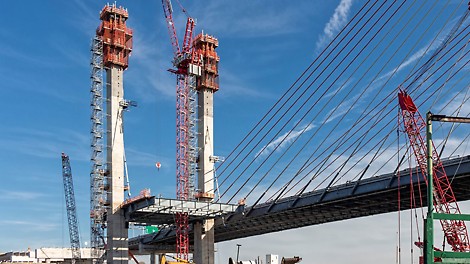
The second phase of the Kosciuszko Bridge replacement project on the east end of Long Island in New York City is now drawing to a close, as crews attach the cables that will support the deck. The new Kosciuszko Bridge is a key element of the Brooklyn Queens Expressway (BQE), which is an integral part of I-278 and one of the few north-south routes in the area. Plans to upgrade this 1.1-mile portion of the BQE have been under serious consideration since 2000. Originally constructed in the 1930s, the old Kosciuszko Bridge was the only crossing of Newtown Creek that was not a drawbridge. In the 75 years since its opening, traffic has grown exponentially while the structure itself has both aged and become functionally obsolete.
The old bridge currently is being replaced by dual cable-stayed bridges in a phased project that also involves a great deal of work on the surface roads and utilities under the predominantly elevated roadway. Phase one of the replacement project, which ran from 2014 to 2017, saw the construction of a new Brooklyn- bound roadway and bridge alongside the existing roadway. Once completed, all traffic was shifted to the new structure, with three lanes of traffic in each direction, enabling the removal of the old bridge. When the second new bridge is completed, it will carry four lanes of westbound traffic plus a pedestrian/ bicycle path. The bridge that was built in phase one will then revert to carrying five lanes of eastbound traffic.
Granite Construction, contractor for phase two of the project, used two PERI RCS (rail climbing system) climbers to build the H-Pylon with two seperate upper stems for the second bridge. Rising roughly 216 feet from the ground surface, each pylon is built on a foundation of four 7-foot-diameter drilled shaft caissons extending 160 to 180 feet to bedrock. To form the hollow rectangular pylon stems, which are about 20 feet by 11 feet at the bottom and taper to about 15 feet by 10 feet at the top, PERI supplied a combination of its VARIO formwork and MAXIMO wall forming system. The contractor opted to preassemble the formwork on site. Both the internal and external formwork systems were then adjusted with each advance, easily changing their shapes to match the profile required for the next concrete placement. Alternating back and forth between the two towers, the contractor placed the concrete in 18 units per side. Although PERI’s rail climbing system can be advanced using self-contained hydraulic lifts, the contractor in this case opted to use the crane instead to move the formwork from one level to the next. Also, because the forming system was designed to be completely tieless, the contractor’s labor and patching costs for the project were significantly reduced. Project completion is expected later in 2019 or early 2020.




